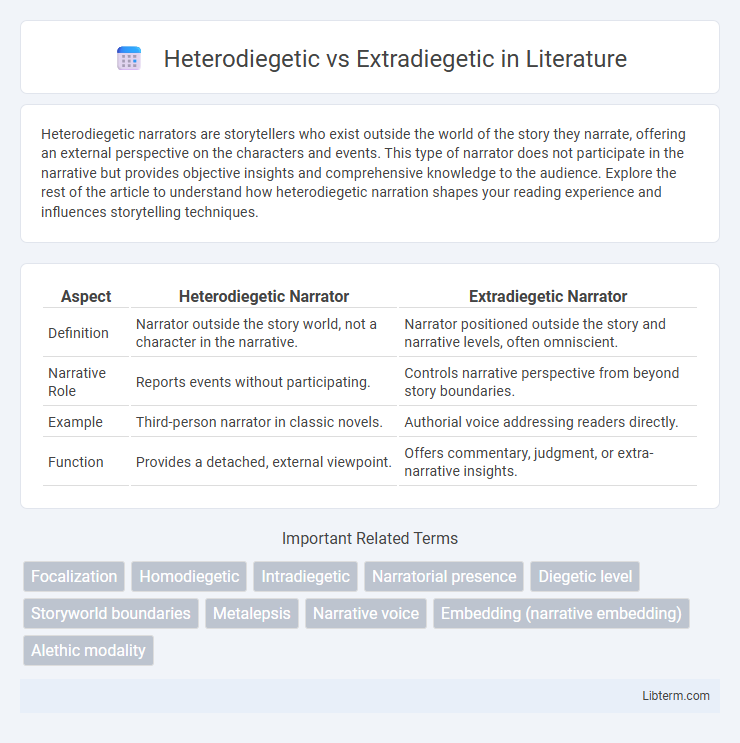Heterodiegetic narrators are storytellers who exist outside the world of the story they narrate, offering an external perspective on the characters and events. This type of narrator does not participate in the narrative but provides objective insights and comprehensive knowledge to the audience. Explore the rest of the article to understand how heterodiegetic narration shapes your reading experience and influences storytelling techniques.
Table of Comparison
| Aspect | Heterodiegetic Narrator | Extradiegetic Narrator |
|---|---|---|
| Definition | Narrator outside the story world, not a character in the narrative. | Narrator positioned outside the story and narrative levels, often omniscient. |
| Narrative Role | Reports events without participating. | Controls narrative perspective from beyond story boundaries. |
| Example | Third-person narrator in classic novels. | Authorial voice addressing readers directly. |
| Function | Provides a detached, external viewpoint. | Offers commentary, judgment, or extra-narrative insights. |
Understanding Narrative Perspectives
Heterodiegetic narrators exist outside the story world and relay events without participating in them, providing an external viewpoint that enhances objectivity and overview. Extradiegetic narrators also operate outside the narrative but typically address the audience directly, shaping interpretation through commentary or framing. Understanding these narrative perspectives is crucial for analyzing how stories convey meaning and influence reader engagement.
Defining Heterodiegetic Narration
Heterodiegetic narration refers to a storytelling perspective where the narrator exists outside the story world and does not participate in the events recounted. This type of narrator provides an external viewpoint, often offering a broader or more objective understanding of characters and plot developments. Heterodiegetic narration contrasts with homodiegetic narration, in which the narrator is also a character within the story.
Exploring Extradiegetic Narration
Extradiegetic narration occurs when the narrator exists outside the story world, providing an overarching perspective that is not confined to any character's viewpoint. This type of narration offers a comprehensive understanding of the plot by delivering information, context, and commentary that characters within the narrative cannot access. The extradiegetic narrator enhances storytelling by creating a layer of analysis and reflection, guiding the audience through the narrative with objectivity and broader thematic insights.
Key Differences Between Heterodiegetic and Extradiegetic
Heterodiegetic narrators are characters outside the story world who recount events without personal involvement, while extradiegetic narrators exist entirely outside all narrative levels, offering an omniscient perspective. The key difference lies in narrative positioning: heterodiegetic narrators occupy a narrative layer within the story's universe but separate from the main action, whereas extradiegetic narrators operate at a higher narrative level, transcending the story environment. Understanding these distinctions enhances comprehension of narrative structure and point of view in literary analysis.
Functions of the Heterodiegetic Narrator
The heterodiegetic narrator operates outside the story world, providing an omniscient perspective that reveals characters' inner thoughts and background information inaccessible to story participants. This narrative mode enhances comprehension by offering a broader context and guiding audience interpretation while maintaining neutrality and objectivity. By controlling narrative pace and focalization, the heterodiegetic narrator shapes thematic emphasis and heightens dramatic irony in the text.
Roles of the Extradiegetic Narrator
The extradiegetic narrator exists outside the story world, offering an omniscient perspective that controls the narrative flow and provides insight into characters and events inaccessible to diegetic narrators. Serving as a guiding voice, this narrator shapes the audience's understanding by inserting commentary, foreshadowing, and thematic interpretations beyond the depicted narrative reality. The role of the extradiegetic narrator is central to framing the story, influencing reader perception, and maintaining an overarching presence that contrasts with heterodiegetic narrators embedded within the story but not participating in the plot.
Examples in Classic and Modern Literature
Heterodiegetic narrators, who exist outside the story world, appear in classic literature such as the omniscient narrator in Jane Austen's "Pride and Prejudice" and remain prevalent in modern works like Kazuo Ishiguro's "Never Let Me Go." Extradiegetic narrators also function outside the narrative but are often more explicitly separate from the action, as seen in Gustave Flaubert's "Madame Bovary" and in contemporary metafictional texts like Italo Calvino's "If on a Winter's Night a Traveler." These narrative modes shape reader perspective by controlling the degree of involvement with characters and events across literary periods.
Impact on Reader Engagement and Perception
Heterodiegetic narrators, who exist outside the story world, often provide an objective and reliable perspective that enhances reader trust and clear understanding. Extradiegetic narrators, being outside the narrative but sometimes omniscient, create a broader contextual view that can deepen reader insight but may distance emotional engagement. The choice between heterodiegetic and extradiegetic narration significantly impacts reader involvement by balancing narrative authority and emotional connection.
Common Misconceptions and Overlaps
Heterodiegetic narrators, who exist outside the story world, are often confused with extradiegetic narrators, though the latter specifically narrate from a position outside the narrative timeline or diegesis. Common misconceptions arise when both terms are used interchangeably to describe narrators who do not participate in the story, overlooking that heterodiegetic narrators remain external whereas extradiegetic narrators function on a different narrative level. Overlaps occur in narratives employing multiple layers of narration, where a heterodiegetic narrator can also assume an extradiegetic role by commenting beyond the immediate story world.
Choosing the Right Perspective for Your Story
Selecting between a heterodiegetic and extradiegetic narrator significantly shapes a story's perspective, influencing reader engagement and narrative depth. A heterodiegetic narrator recounts events from an external viewpoint without participation, ideal for maintaining objectivity and a broader scope. In contrast, an extradiegetic narrator exists outside the story world entirely, offering a god-like omniscient perspective, which can provide comprehensive insight into characters and plot, enhancing thematic complexity.
Heterodiegetic Infographic

 libterm.com
libterm.com